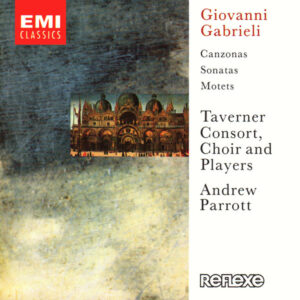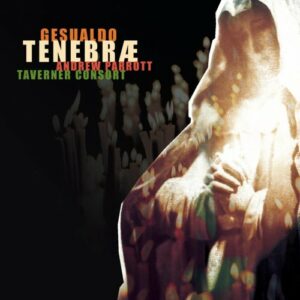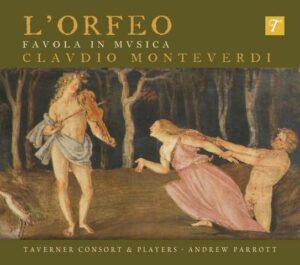Program: #23-39 Air Date: Sep 25, 2023
To listen to this show, you must first LOG IN. If you have already logged in, but you are still seeing this message, please SUBSCRIBE or UPGRADE your subscriber level today.
There are few major figures in the field we have not had as a guest in our program’s history; one of these is the great Andrew Parrott with his Taverner Consort. This week, music of Gabrieli, Gesualdo, and Monteverdi.
NOTE: All of the music on this program comes from the ensemble the Taverner Choir directed by our guest Andrew Parrott. For complete information about this ensemble: https://www.taverner.org/
I. Giovanni Gabrieli: Canzonas, Sonatas, Motets. EMI CD CDC 7 54265-2.

From Gramophone: The insert-notes announce this disc as containing ''recent discoveries and first recordings on period instruments'' but neglect to tell us which are which. That's a pity, because in fact some of these pieces come into neither category. However, as far as I am able to establish, all the vocal works are new to the catalogue (though Audite principes has been recorded in a very similar version by Hyperion—12/90), while of the instrumental pieces the Canzon XVII a 12 has not been recorded before and the Sonata XVIII a 14, the Sonata XX a 22 and the Canzona in echo duodecimi toni are 'firsts' on period instruments. I fully expect to be corrected by someone, but I wish that EMI, having mentioned it, had made it clear in the first place.
Still, more important than all that is the fact that this is a nicely planned selection of vocal and instrumental numbers by the greatest master of the Venetian polychoral style, given under the direction of a conductor who has a great deal of experience in this repertoire. Here he chooses to explore the timbral beauties of the music rather than noisily playing one choir off against another, or probing over-insistently for other types of textural detail. Consequently this is a mellow, relaxed set of performances in which the sound is never forced, whether a piece be in four parts or 22. The solo voices (the Taverner Choir only appears in one piece) are treated rather as if they were just so many more instruments, with Parrott being content most of the time to leave them well embedded in the overall sound. If things can seem a trifle impersonal as a result, there are benefits to such a laid-back approach, particularly in the way in which the more massive numbers acquire an impressive ease, possessed of all the latent power of a smooth-running Rolls Royce. Just like one of those vehicles, this disc is neither thrilling nor radical—but it is beautifully made.’
- Dulcis Jesu à 20 (C128; 2 tenors, chorus, 4 cornets, 2 violas, 8 sackbuts, theorbos, organs, curtal, violone)
- Sonata pian e forte à 8 (C175 1597; cornet, violin, 6 sackbuts, organs, violone)
- Jubilate Deo à 8 (C135; 4 voices, cornet, 3 sackbuts, theorbos, organ, curtal)
- Sonata à 14 (C211 1615; 4 cornets, 10 sackbuts, theorbos, organs)
- O Jesu mi dulcissime à 8 (C140; 8 voices, theorbos, organs)
- Canzon à 12 (C210 1615; 3 cornets, 3 violins, 6 sackbuts, theorbos, organs, violone)
- Hic est filius Dei à 18 (C132; soprano, 2 countertenors, bass, 2 cornets, 12 sackbuts, theorbos, organs, bass violin)
- Sonata con tre violini (C214 1615; 3 violins, organ, theorbo)
- Sonata à 22 (C213 1615; 6 cornets, 16 sackbuts, theorbos, organs, violone)
- Miserere mei Deus à 4 (C137; 4 voices, organ)
Gloria Patri à 8 (C136; 4 voices, 2 cornets, 2 sackbuts, theorbos, organ, violone) - Canzon in echo duodecimi toni à 10 (C180 1597; 8 cornets, 2 sackbuts, theorbos, organs)
- Audite principes à 16 (C123; countertenor, 2 tenors, 5 cornets, 8 sackbuts, theorbos, organs, curtal, violone)
II. Gesualdo Tenebrae. Sony CD SK 62977.

From Classics Today: Gesualdo definitely takes the cake for sheer weirdness among Renaissance composers. Perhaps because he was enormously wealthy and had to please no-one with his musical compositions, he opted for great harmonic experiments to help him with his word painting. A soul in trouble in Gesualdo’s music, believe me, is a soul in trouble; I might add that a choir singing this music could get into an equal amount of trouble. This brilliant CD presents nine motets–Tenebrae Responories from the Good Friday liturgy–and Andrew Parrott has wisely,and kindly, included a few moments of chant between them. Had he not, this program would be almost too much to take. The cruel dissonances, eccentric rhythmic and harmonic changes, suspensions which can create a type of dizziness, all are so disorienting that the chant grounds us anew and gives our ears and souls time to rest. Suffice it to say that these performances are flawless: The singers are spot on at all times and no technical switch seems too difficult for them. The group’s three countertenors are formidably mellow and the lower voices handsome. This is tough stuff, perhaps to be taken in 20 minute bits, but it’s worth all the trouble it puts our minds to. Simply ravishing.
Tenebræ Responses For Good Friday (Responsoria, 1611)
In I. Nocturno
- Antiphon – Astiterunt Reges Terrae / Psalm – Quare Fremuerunt Gentes (Ps 2) / Antiphon – Astiterunt Reges Terrae
- Lectio I – De Lamentatione ... Heth
- Resp. I – Omnes Amici Mei
- Lectio II – Lamed
- Resp. II – Velum Templi
- Lectio III – Aleph
- Resp. III – Vinea Mea Electa
In II. Nocturno
- Antiphon – Alieni Insurrexerunt / Psalm – Deus In Nomine Tuo (Ps 53) / Antiphon – Alieni Insurrexerunt
- Lectio IV – Ex Tractatu ... Protexisti Me
- Resp. IV – Tamquam Ad Latronem
- Lectio V – Tanta Opera Bona
- Resp. V – Tenebrae Factae Sunt
- Lectio VI – Exacuerunt Tamquam
- Resp. VI – Animam Meam Dilectam
In III. Nocturno
- Antiphon – Captabunt In Animam Justi / Psalm – Deus Ultionum Dominus (Ps 93) / Antiphon – Captabunt In Animam Justi
- Lectio VII – De Epistola ... Festinemus
- Resp. VII – Tradiderunt Me
- Lectio VIII – Adeamus Ergo
- Resp. VII – Jesum Tradidit Impius
- Lectio IX – Nec Quisquam
- Resp. IX – Caligaverunt Oculi Mei
III. Claudio Monteverdi: L’Orfeo. Avie CD AV2278.

From Classical net: Andrew Parrott and his Taverner Consort and Players are amongst the oldest, best established and most widely respected pioneers of the "early" music movement, if so it can still be called. This year (2013) is their fortieth anniversary; and here's a splendid, sensitive, unsensational and meticulously researched and prepared performance of one of the Baroque's greatest and most enduring vocal works, Monteverdi's L'Orfeo. Recorded this time last year in Oxford and presented here with sober flare on Avie, this two-CD set (at an hour and three quarters) of what's really the first opera easily takes its place as one of the best available from a group of well over two dozen. A worthy reference recording.
The last couple of releases of L'Orfeo which we've looked at here were those by Vartolo on Brilliant Classics 94373 and Cavini on Glossa GES920913-E. They're very different. This L'Orfeo of Parrott's is less muscular, is not superficially forceful, is less pressing. But it lacks nothing in impact or beauty. It's delightful music-making.
First performed in Mantua in 1607, L'Orfeo is a favola in musica, a story told with music. That's how Parrott approaches it here. His measured and balanced approach to rendering and realizing the solo and ensemble vocal and instrumental essence of the work is both exemplary and stimulating. Though it's as communicative and full of life as it is gentle and seemingly light of touch. In fact, a great deal of thought has gone into instrumental choices and combinations. It's an informed rethink and reluctance to default to the doctrinaire paring down of the palette, rather than a fake sense of the demur, of the reticent, that make this account work. It's still highly musical.
It's not merely that the tempi are sedate, the singers' articulations unfussy yet direct, the overall texture of the ensemble and smaller groupings beautifully focused and clear, nor the sense of purpose in the forward momentum of the work unambiguous. They all are. Nor is the chief reason why this is such a good L'Orfeo the technical excellence of the performers, though of course they do play and sing with great insight and fully rounded and accomplished style. Rather, Parrott has a vision for Monteverdi's work that seems to have begun by comprehending and embracing every aspect of the work: the novelty of the emerging operatic genre; its approach to human frailty and love; the blend of words and music. He has ruminated long and hard on the issues, and then allowed a highly integrated and balanced whole to emerge. It's a whole that convincingly and deftly accesses the very essences of the drama: love; despair; consolation and partial resolution; and perhaps hope.
Parrott has taken particular care with the textures of strings and brass. With the pitch (440 was adopted). With the casting of La Musica as a countertenor (David Hurley). With ways to make stage conventions such as the ballettoeffective; and ways to match effects to the dramatic intention. And not least with the libretto itself. None of these was done purely in the service of authenticity. Rather to present to an attentive audience a truly persuasive and beautiful L'Orfeo. A holistic conception. No intrusive loose ends. Nothing extraneous. Little that sounds like an experimental attempt to imagine any spontaneity that might have attended first performances four hundred years ago. But a completely convincing and successful modern account. Yet one that is fully in accord with Baroque practice.
Charles Daniels' Orfeo is superb. His enunciation is clear and idiomatic. His tone sweet and approachable. This furthers our perception of Monteverdi's work as being first and foremost about human beings and their concerns. Although following classical conventions, Monteverdi's L'Orfeo is a humanist work. This is re-inforced by the fact that the libretto, albeit all in verse, has few declamatory moments, and precious little repetition. Rhetoric is not a major tool. Self-knowledge and psychological insight are more important. This performance, though, does not compromise musicality by allowing textual exposition to swamp melody or harmony. Although deliberate, the singers' delivery is always thoughtful and convincingly imaginative.
The passages towards the start of Act III [CD.2 tr.s 5,6], for instance, when Orpheus is abandoned by Hope are played here like the most loving and lovingly-crafted of sepia close-up photographs. Everything is almost in slow motion, every note of the chitarone is audible; every note precisely underlines the shocking climacteric as the hero makes his own way across the Styx. Yes, the tempo is very slow. But the result is neither weakly mellow nor languorous. It's intense, roseate, distilled to the very essence of Orpheus' emotional state: determination bolstered by love and loss. It would have been easy – as indeed some recordings do – to rely on imagined "stock" emotions, archetypes. In this case, though, the very personal response of Daniels' Orpheus is so convincing as to become itself a universal one. Then, as that Act ends, the – again gently, gracefully – expressive chorus of the infernal spirits comments. Parrott does not make them particularly sapient. Nor privileged. Yet the dignity of the pace with which their number unfolds [CD.2 tr.10] conveys the prefect distance and relevance of what they say. This steadiness makes the contrast with animated moments such as in "O dolcissimi lumi", when Euridice is nearly rescued [CD.2 tr.15] all the greater and more telling.
The acoustic is forward, pleasing, resonant yet intimate. Oxford's Church of St. Michael and All Angels is well known for peaceful presence. Just what was needed for Parrott's conception of L'Orfeo, where human emotions and fragility are contrasted with "heavenly" aspirations and the nature of the inevitable. The music has to make its own case for being adjunct to the text. In this recording that amalgam works very well. Although it has a chamber quality to it, listen more carefully and you'll actually hear individual colors and nuances of individual instrumental and vocal lines and ideas, pre-occupations and concerns. The engineers have done this project proud. The extended booklet that comes with the CDs is packed with all manner of useful and relevant information, including the complete text in Italian and English. It's really impossible to recreate the first performance of L'Orfeo over 400 years ago. Though it is possible to create a good speculatively appropriate and appropriately-satisfying atmosphere. To sense what Monteverdi intended. And thus to arrive at a performance which is beautiful and stimulating in its own right. That's what Parrott and his forces have done and what makes this set so rewarding and easy to recommend without hesitation on every count.
Copyright © 2013, Mark Sealey
L'Orfeo
- Anna Dennis, soprano (Ninfa)
- Emily Van Evera, soprano (Proserpina, Messaggiera)
- Faye Newton, soprano (Euridice)
- Clare Wilkinson, mezzo-soprano (Speranza)
- David Hurley, countertenor (La Musica)
- Rodrigo del Pozo, high tenor (Pastore)
- Charles Daniels, tenor (Orfeo)
- Gareth Morrell, tenor (Pastore, Spirito infernale)
- Simon Wall, tenor (Pastore, Eco)
- Richard Latham, baritone (Spirito infernale)
- Guy Pelc, baritone (Apollo)
- James Arthur, bass-baritone (Spirito infernale)
- Robert MacDonald, bass (Pastore, Spirito infernale)
- Christopher Purves, bass (Plutone)
- Curtis Streetman, bass (Caronte, Spirito infernale)
Taverner Consort & Players/Andrew Parrott
Avie AV2278
Composer Info
Giovanni Gabrieli, Gesualdo Tenebrae, Claudio Monteverdi
CD Info
EMI CD CDC 7 54265-2, Sony CD SK 62977, Avie CD AV2278